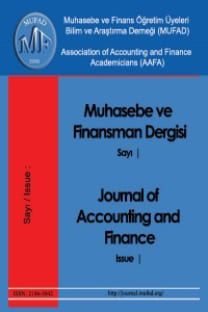Kıdem tazminatı fonu'nun aktüeryal prim oranı hesaplamaları ve muhasebesi
Kıdem tazminatı, İş Hukukumuza 1936 yılında 3008 sayılı İş Kanunu ile girmiştir. Yıllar itibari ile İş Hukukundaki değişiklikler sonucu kıdem tazminatı; işçi açısından giderek önemi artan bir hak, işveren açısından ise yükü giderek artan bir maliyet unsuru haline gelmiştir. İlk defa 1975 yılında fon kavramından bahsedilmiş ve 2002 yılında Kıdem Tazminatı Fonu Yasa Tasarısı gündeme gelmiştir. Literatürde, kıdem tazminatı fonunun muhasebe ve finansman açısından ne gibi etkileri olacağı üzerine herhangi bir akademik çalışmaya rastlanılmamaktadır. Bu çalışma, Kıdem Tazminatı Fonu Yasa Tasarısı yasalaşması durumunda prim oranının nasıl belirlenmesi gerektiği ve muhasebe kayıtlarının nasıl yapılacağını belirleme amacı taşımaktadır. Aktüeryal prim oranı hesaplamaları, regresyon modeli ile oluşturulan çeşitli senaryolar altında yapılmış ve prim oranının % 6 civarında olmasının her iki taraf açısından en uygun çözüm olduğu sonucuna ulaşılmıştır. Ayrıca, bir maliyet unsuru olan kıdem tazminatının, prim tutarları muhasebesinin basitleştirilmesi üzerine tartışılmış ve kayıtlar konusunda muhasebe temel kavramları çerçevesinde öneriler sunulmuştur.
Severance Payment fund accounting and the actuarial calculation of premium rate
Severance pay became a main discussion issue in 1936 in Turkish Labor Law literature. Since that year,severance pay has been a conflict between employees and employers. In 1975, fund term became a maindiscussion issue in Turkey with the Turkish Labor Law no.1927. Severance Payment Fund has become ALegislation Draft in 2002. In the literature, there exists no study involving the impact of severance pay over thefinancial accounting. This study aims to determine premium rate of severance payment and to illustrate theaccounting records in the framework of Legislation draft and Generally Accepted Accounting Principals. Thepremium rate of severance payment was estimated by using Ordinary Least Square (OLS) method with severalscenarios. The results show that the appropriate rate for both sides (employees and employers) is the ratearound 6%.
___
- Acat, M. Bahaddin-Yenilmez, Kürşat. (2004), Eğitim Fakültesi Öğrencilerinin Öğretmenlik Mesleğine İlişkin Motivasyon Düzeyleri, Manas Sosyal Bilimler Dergisi , Sayı 2, s. 125-139.
- Arquero, Jos L.-Byrne, Marann-Flood, Barbara-Gonzalez, Jos Mara. (2009), Motives, Expectations, Preparedness and Academic Performance: a Study of Students of Accounting at a Spanish University, Revista de Contabilidad - Spanish Accounting Review, Vol. 12, No. 2, s. 279-299.
- Baxter, Arthur-Hatt, Sue. (2000), Everything Must Go! Clearing and First-Year Performance, Journal of Further and Higher Education, Vol. 24, No. 1, s. 5-14.
- Bennett, Roger. (2003), Determinants of Undergraduate Student Drop Out Rates in a University Business Studies Department, Journal of Further and Higher Education, Vol. 27, No. 2, s. 123-141.
- Brinkworth, Russell-McCann, Ben-Matthews, Carol-Nordström, Karin. (2009), First Year Expectations and Experiences: Student and Teacher Perspectives Higher Education, Vol.58, s. 157-173.
- Byrne, Marann-Flood, Barbara. (2005), A Study of Accounting Students' Motives, Expectations and Preparedness for Higher Education, Journal of Further and Higher Education, Vol. 29, No. 2, s. 111-124.
- Byrne, Marann-Flood, Barbara. (2007), Exploring the Antecedents of Learning Approaches: A Study of International Business Students, International Journal of Management Education, Vol. 6, No. 2, s. 44-62.
- Byrne, Marann-Flood, Barbara. (2008), Examining the Relationships Among Background Variables and Academic Performance of First Year Accounting Students at an Irish University, Journal of Accounting Education, Vol. 26, s. 202-212.
- Cook, Anthony-Leckey, Janet. (1999), Do Expectations Meet Reality? A Survey of Changes in First-Year Student Opinion, Journal of Further and Higher Education, Vol. 23, No. 2, s. 157-171.
- Donald, Janet G. (1999), Motivation for Higher-Order Learning, New Directions for Teaching and Learning, No.78, s. 27-35.
- Jansen, Ellen P.W.A.- Van der Meer, Jacques. (2007), Feeling Prepared for University? Perceived Preparedness and Expectations of Prospective Students, 10th Annual Pacific Rim First Year in Higher Education Conference, February, Brisbane, s. 1-10.
- Nelson, Karen-Kift, Sally-Clarke, John. (2008), Expectations and Realities for First Year Students at an Australian University, 11th Pacific Rim Conference on the First Year in Higher Education : First Year in Higher Education Conference, Hobart-Tasmania, s.1-9.
- Pancer, S. Mark-Pratt, Michael-Hunsberger, Bruce-Alisat, Susan. (2004), Bridging Troubled Waters: Helping Students Make the Transition from High School to University, Guidance&Counselling, Vol.19, No. 4, s. 184-190.
- Paulsen, Michael B.- Gentry, James A. (1995), Motivation, Learning Strategies, and Academic Performance: A Study of the College Finance Classroom, Financial Practice and Education, Vol. 5, No. 1, s. 78-89.
- Taylor, Janet- Mander, Alison. (2007), Studying at University: Early Perceptions and Experiences of First Year Service Mathematics Students, Studies in Learning, Evaluation Innovation and Development , Vol.4, No. 3, s. 29-43.
- Tinto, Vincent. (1975), Dropout from Higher Education: A Theoretical Synthesis of Recent Research, Review of Educational Research, Vol. 45, No. 1, s. 89-125.
- Yenen, Zeki-Gözlü, Sıtkı. (2003), Yükseköğretimde Müşteri Beklentileri: Türkiye'den Örnekler, İTÜ Dergisi , Cilt 2, Sayı 2, Nisan, s. 28-38.
- ISSN: 2146-3042
- Yayın Aralığı: 4
- Başlangıç: 2005
- Yayıncı: Muhasebe ve Finansman Öğretim Üyeleri Derneği (MUFAD)
